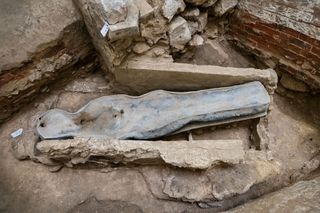
A mysterious “horseman” found inside a lead-lined coffin beneath the ruin of the Notre Dame Cathedral has finally been identified as the French Renaissance poet Joachim du Bellay, according to forensic experts.
The preserved remains, discovered beneath Notre Dame’s nave in 2022, were stored inside a sealed sarcophagus near those of the high priest Antoine de la Porte during excavations that followed the fire at the cathedral in 2019.
An analysis by the Toulouse University Hospital’s forensic institute revealed that the skeleton of the man inside showed signs of bone tuberculosis, chronic meningitis and a proclivity for riding horses — earning the man his nickname.
Now, these details have led Dr. Éric Crubézy, a professor of biological anthropology at the University of Toulouse IIIand research director at the France’s National Centre for Scientific Research, to hypothesize the man’s identity. The findings were announced Sept. 17 in a translated statement by France’s National Institute of Preventive Archaeological Research (INRAP).
“He matches all the criteria of the portrait,” Crubézy said at a Sept. 17 news conference, per La Croix. “He is an accomplished horseman, suffers from both conditions mentioned in some of his poems, like in ‘La Complainte du désespéré,’ where he describes ‘this storm that blurs [his] mind,’ and his family belonged to the royal court and the pope’s close entourage.”
“He rode from Paris to Rome, which is no mean feat when you have tuberculosis like he did. In fact, he almost died from it,” Crubézy added.
Related: Notre Dame is held together by a first-of-its-kind ‘iron skeleton,’ catastrophic fire revealed

Born in Anjou in western France’s Loire Valley in 1522, du Bellay later moved to Paris and Rome where he composed his seminal works during the French Renaissance, including a renowned defense of French as an artistic language whose literature could rival the “quality and expressiveness” of ancient Greece and Rome. After years of poor health, du Bellay died in 1560 at age 37.
Following his death, the poet’s remains were thought to be buried at Notre Dame alongside those of his relative and clergyman Jean du Bellay. Jean’s remains were found buried beneath the building’s chapel, yet despite years of searching, Joachin du Bellay’s tomb was never found.
Following the 2019 fire, archaeologists working on the cathedral’s restoration discovered more than 100 graves buried beneath it, including the two sarcophagi near the cathedral’s transept crossing, the intersection of the building’s nave with its transept, the part of the cathedral that form the “arms” of the cross. The coffins’ human remains were sealed behind lead to keep out moisture and prevent decomposition.
However, not every archaeologist involved in the excavation is convinced that the skeleton belongs to du Bellay. Speaking at the press conference, Christophe Besnier, a dig leader and archaeologist with INRAP, said that isotope analysis suggested the man grew up in the Paris or Lyon regions, not Anjou. Isotopes, or variations of elements with a differing number of neutrons in their nuclei, are consumed through diet and drinking water, before making their way into people’s teeth and bones. Crubézy responded that du Bellay grew up living with Jean du Bellay, who had served as the bishop of Paris.
“What more can we have?” INRAP president Dominique Garcia said in an interview with Le Monde. “Find [du Bellay’s] toothbrush to check that the DNA matches? His age and pathology alone offer remarkable statistical solidity.”
 Print
Print


